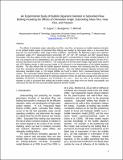| dc.contributor.author | Sugrue, Rosemary M | |
| dc.contributor.author | Buongiorno, Jacopo | |
| dc.contributor.author | McKrell, Thomas J. | |
| dc.date.accessioned | 2017-04-13T19:15:41Z | |
| dc.date.available | 2017-04-13T19:15:41Z | |
| dc.date.issued | 2014-09 | |
| dc.date.submitted | 2014-07 | |
| dc.identifier.issn | 0029-5493 | |
| dc.identifier.uri | http://hdl.handle.net/1721.1/108139 | |
| dc.description.abstract | The effects of orientation angle, subcooling, heat flux, mass flux, and pressure on bubble departure diameter in the isolated bubble regime of subcooled flow boiling were studied by high-speed video in a two-phase flow loop that can accommodate a wide range of flow conditions. Specifically, the following ranges were explored: orientation angles of 0° (downward-facing horizontal), 30°, 45°, 60°, 90° (vertical), and 180° (upward-facing horizontal); mass flux values of 250, 300, 350, and 400 kg/m2 s, corresponding to Froude numbers between 0.42 and 1.06; pressures of 101 (atmospheric), 202, and 505 kPa; two values of the subcooling degrees (10 and 20 °C); and two heat fluxes (0.05 and 0.10 MW/m2). The combination of the test section design, high-speed video camera and LED lighting results in high accuracy (order of 20 μm) in the determination of the bubble departure diameter. The data indicate that the bubble departure diameter increases with increasing heat flux, decreasing mass flux, decreasing subcooling, and decreasing pressure. Also, the bubble departure diameter increases with decreasing orientation angle, i.e. the largest bubbles are found to detach from a downward-facing horizontal surface. The mechanistic bubble departure diameter model of Klausner et al. and its recent modification by Yun et al. were found to correctly predict all the observed parametric trends, but with large average errors and standard deviation: 65.5 ± 75.8% for Klausner's and 37.9 ± 51.2% for Yun's. Since the cube of the bubble departure diameter is used in subcooled flow boiling heat transfer models, such large errors are clearly unacceptable, and underscore the need for more accurate bubble departure diameter models. | en_US |
| dc.description.sponsorship | Douglas C. Spreng Fund | en_US |
| dc.description.sponsorship | Nuclear Energy Institute | en_US |
| dc.language.iso | en_US | |
| dc.publisher | Elsevier | en_US |
| dc.relation.isversionof | http://dx.doi.org/10.1016/j.nucengdes.2014.08.009 | en_US |
| dc.rights | Creative Commons Attribution-NonCommercial-NoDerivs License | en_US |
| dc.rights.uri | http://creativecommons.org/licenses/by-nc-nd/4.0/ | en_US |
| dc.source | Prof. Buongiorno via Chris Sherratt | en_US |
| dc.title | An experimental study of bubble departure diameter in subcooled flow boiling including the effects of orientation angle, subcooling, mass flux, heat flux, and pressure | en_US |
| dc.type | Article | en_US |
| dc.identifier.citation | Sugrue, R.; Buongiorno, J. and McKrell, T. “An Experimental Study of Bubble Departure Diameter in Subcooled Flow Boiling Including the Effects of Orientation Angle, Subcooling, Mass Flux, Heat Flux, and Pressure.” Nuclear Engineering and Design 279 (November 2014): 182–188. © 2014 Elsevier B.V. | en_US |
| dc.contributor.department | Massachusetts Institute of Technology. Department of Nuclear Science and Engineering | en_US |
| dc.contributor.approver | Buongiorno, Jacopo | en_US |
| dc.contributor.mitauthor | Sugrue, Rosemary M | |
| dc.contributor.mitauthor | Buongiorno, Jacopo | |
| dc.contributor.mitauthor | McKrell, Thomas J | |
| dc.relation.journal | Nuclear Engineering and Design | en_US |
| dc.eprint.version | Author's final manuscript | en_US |
| dc.type.uri | http://purl.org/eprint/type/JournalArticle | en_US |
| eprint.status | http://purl.org/eprint/status/PeerReviewed | en_US |
| dspace.orderedauthors | Sugrue, R.; Buongiorno, J.; McKrell, T. | en_US |
| dspace.embargo.terms | N | en_US |
| dc.identifier.orcid | https://orcid.org/0000-0002-8406-6298 | |
| mit.license | PUBLISHER_CC | en_US |
